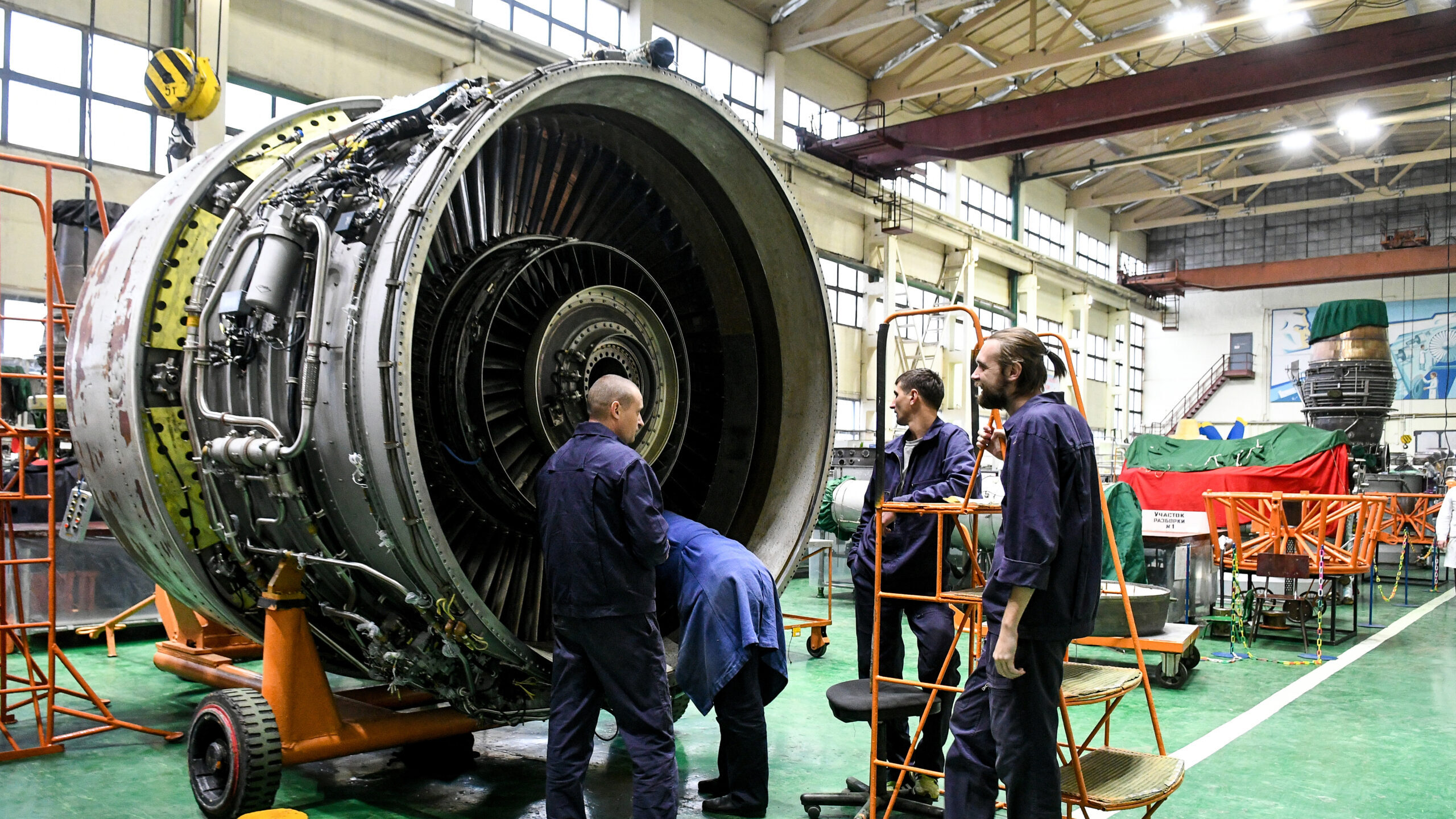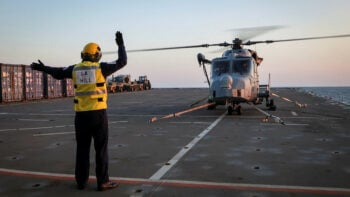
Employees stay by an engine at the Ivchenko-Progress State Enterprise, Zaporizhzhia, southeastern Ukraine on Dec. 13, 2019. (Dmytro Smolyenko/ Ukrinform/Future Publishing via Getty Images)
PARIS AIR SHOW — Throughout the war in Ukraine, the country’s Ivchenko/Progress Design Bureau (OKB) has continued to develop propulsion systems for Kyiv’s military, despite the ever-present threat of Russian attacks, including on the city of Zaporizhzhiya, where the organization is located.
The threat of a direct hit on the plant is not a theoretical one. Throughout the war other defense industrial facilities have found themselves in the Russian sights, like when the L’viv State Aircraft Repair Plant, which is the most experienced and capable overhaul facility for the Mikoyan MiG-29 and other Russian-design aircraft in Ukraine Air Force inventory, was struck near the outset of the war.
That means going to work every day comes with an unusual threat to workers’ lives. But as the conflict continues, and for just a brief respite, company representatives managed to journey thousands of miles to the Paris Air Show last week, in part to advertise their work like every other defense firm there, but also to show the world they’re still in the fight.
One company representative, whose name is being withheld for their safety, said the organization was there to not only “show the flag,” but to “demonstrate that we are continuing to support the armed forces and keep the OKB functioning. All of us are part of the war effort even though we are not at the front.”
Even getting to Paris wasn’t exactly simple. OKB representatives who spoke to Breaking Defense at the Le Bourget aerodrome said they had made the journey to the expo only by transiting a neighboring country where air traffic is still in operation. The team also had to prepare documentation officially authorizing them to leave the country due to delegation members still being of military age.
No provisions could be made for actually bringing aeroengines to be put on display — not even models — and one delegation member explained, ”we could only carry paper brochures and other easily transportable items.”
Down To Business
Beyond representing Ukraine’s aerospace sector generally, Ivchenko was there to do business. On the first day of the show Ivchenko’s General Director, Igor Kravchenko, signed a memorandum of understanding with the Czech aerospace firm PBS for the co-development of a new small jet engine. The design, designated AI-PBS-350, is intended for use in cruise missiles, anti-ship missiles and other unmanned vehicle applications.
Developmental work and production will be carried out by the aeroengine division of the Czech company, První brněnská strojírna Velká Bíteš, a. s., a well-known global manufacturer of high-speed turbine designs for the aerospace, power and transport industries.
The AI-PBS-350 is close in performance to another Ukraine-built small, unmanned vehicle propulsion system, the MS-400 manufactured at the Motor Sich aeroengine production association that is also co-located with the Ivchenko/Progress OKB. (Motor Sich also worked in collaboration with L’viv State Aircraft Repair Plant, which came under Russian attack.) The new design the Ukraine firm will be developing with PBS is expected to produce slightly lower thrust than the MS-400 (765 pounds vs. 880 pounds), but at 112 pounds, its dry weight is also 65 pounds lighter than the older-model Motor Sich-built engine.
The new Ukraine-Czech engine has a design that company promotional materials describe as being optimized for “single-mission” applications. Its primary application will be for a subsonic cruise missile design, several of which have been under development by Ukrainian defense enterprises. For example, Kyiv-based State Design Bureau (DKB) Luch designed the R-360 Neptune anti-ship missile that has been credited with the sinking of the Russian Navy’s Black Sea Fleet flagship the Moskva on 13 April 2022.
Ivchenko/Progress also have a long history of cooperation with Czech industry. Kravchecnko told Breaking Defense that the companies have engaged in joint projects since 2006 and that “this new engine will fit well into the Czech company’s already extensive line of unmanned vehicle propulsion systems.”
Other Plans
The Ukrainian aeroengine design bureau has previously demonstrated its capacity for innovation on more than one occasion. One example is how the afterburning variant of the AI-222-25 engine that is installed in the PRC-made Hongdu L-15 jet trainer was developed.
“There was no aeroengine company or propulsion design enterprise that helped us in developing an afterburner for our engine,” said one Ivchenko representative. “This was something we did entirely on our own as we see a market for a more powerful-performing engine in this thrust class. But we realized no other company was going to step up and make it easier for us to compete with them by designing the afterburner for us.”
The company is also in plans to make a fighter jet engine in the class of the GE F414 powerplant currently installed in the Boeing F/A-18E/F Super Hornet. This engine, the AI-9500F, would produce about a thousand pounds less thrust than the US design. The Ukrainian firm said it has yet to find a customer to cooperate in the prototype construction phase and the application to a lightweight fighter design.
“The world market currently has several [non-US] aircraft in final stages of development that require an engine with the performance of the US-made F414,” said a Polish defence and aerospace industry analyst who spoke with Breaking Defense from Warsaw. “This is the kind of a product that could offer those manufacturers the power plant that they need, but its appeal is that it would come without the technology export constraints that of a US military system.”






















